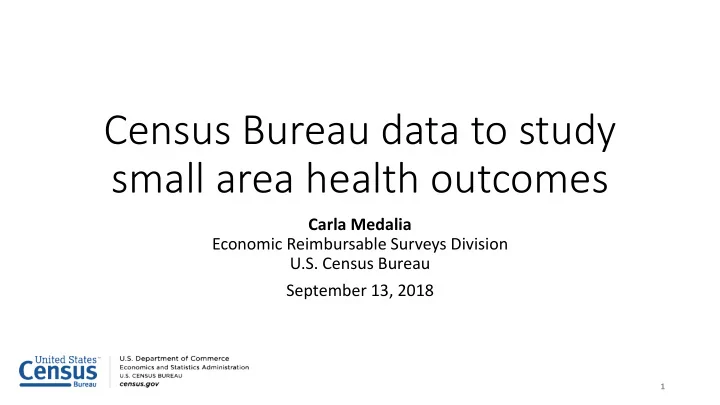

Census Bureau data to study small area health outcomes Carla Medalia Economic Reimbursable Surveys Division U.S. Census Bureau September 13, 2018 1
Outline 1. Six current projects that: 1. Build and evaluate Census Data Linkage Infrastructure 2. Produce statistics 3. Engage in evidence-building research 2. Access and more information 3. Final thoughts – new partnerships 2
1. Data Linkage Infrastructure • Links federal , state , local , and third party administrative records to census and survey data • Required by law to reuse data from other agencies (13 U.S.C. §6) • Lower survey costs • Reduce respondent burden • Data linked at person-level using anonymized keys 3
1. Data Linkage Infrastructure Federal Data State Data Internal Revenue Service Unemployment Insurance Research topics Social Security Administration Women, Infants and Children People and households Medicare and Medicaid Temporary Assistance for Needy Families Housing and Urban Development Supplemental Nutritional Assistance Program Employment Veteran’s Administration Low Income Energy Assistance Program Wages and earnings Office of Personnel Management Childcare Subsidy U.S. Postal Service Education California Franchise Tax Board Childcare Development Fund Public assistance Selective Service Census Bureau Disability Household surveys Food security Decennial census Economic data Health care Longitudinal Business Housing Database Public services and utilities Locality Data Third Party Data Business Homeless Management Information Coreogic System RealtyTrac Puerto Rico tax returns Targus Note: access depends on data acquisition agreements 4
1. Data Linkage Infrastructure Mat atch ratio io of 2010 2010 Censu sus a and administrati tive e records ( (per ersons by county)
2. Mortality Disparities in American Communities (MDAC) • MDAC is American Community Survey (ACS) linked to mortality outcomes from National Death Index (NDI) • Goal: to study relationship between demographic and socioeconomic factors and differentials in U.S. mortality rates 6
2. MDAC data ACS NDI Environmental Sample 2008 ACS (~4.5M people) Deaths occurring 2008-2015 Varies (~269K deaths) Types of data - Demographics - All information from Death - Local/state/national park - SES and employment, Certificate: age, sex, race, locations - Disability, health insurance Hispanic, education, - American Hospital - Household characteristics occupation (varies by state) Association annual survey - Group quarters - Cause of death (ICD-9 and - National Crime ICD-10): underlying and Victimization Survey multiple contributing - RAND Center for causes Population Health and Health Disparities Data Linkage Person-level Person-level Census tract or lat/long 7
3. Small Area Health Insurance Estimates (SAHIE) • Model-based health insurance coverage estimates at state and county geographies • Only source of single-year health insurance coverage estimates for all U.S. counties • Provides estimates beginning from year 2000 • Characteristics: age, sex, income (poverty ratios), and race and Hispanic origin 8
3. SAHIE data sources American Community Survey (1-year and 5-year) • Census 2010 (housing tenure, % rural tabulations) • Population estimates • County Business Patterns • Aggregated federal 1040 tax returns • Supplemental Nutrition Assistance Program (SNAP) participation records • Medicaid participation records • Children's Health Insurance Program (CHIP) participation records • 9
4. Improving fertility measurement • Create fertility histories from Decennial Census, household surveys, tax data, and other administrative data • Experimental data on policy change (Michigan) • Can be used to understand: • Fertility for demographic subgroups and at smaller geographic areas • Undercount of young children in Censuses and surveys • Policy changes at local levels and by demographic subgroups 10
5. Enhancing health data pilot • Objective: to obtain electronic health records and medical claims data • Link health data to existing Census data linkage infrastructure • Research on social determinants of health • Determine whether health data can improve surveys • Potential partners: • Utah Department of Health • Colorado Health Information Exchange • Centers for Medicare and Medicaid Services • New partners… 11
6. Automating disclosure avoidance • The Census Bureau must: • Release high quality data to public • Protect confidentiality (U.S. Code Title 13, Title 26, and others) • Disclosure avoidance addresses these needs, but is • Costly and time consuming • Subject to human error • Disclosure avoidance modernization • Methodological advances in disclosure avoidance • Process modernization 12
6. Automating disclosure avoidance • Vision: dramatically streamline process of disclosure avoidance for users, while integrating modern disclosure avoidance techniques • How: leverage unique authority of National Technical Information Service (NTIS) to access experts • Potential prototype: privacy-preserving small-area estimation 13
Access Project Public use file Restricted data* Externally via Federal Internally at Statistical Research Data Census HQ with Centers (FSRDCs) Census sponsor 1. Data Linkage Infrastructure No Yes Yes 2. Mortality Disparities in American Planned for late 2018 Yes Yes Communities (MDAC) 3. Small Area Health Insurance Yes, also: interactive tool Yes Yes Estimates (SAHIE) and Census Bureau’s API 4. Improving fertility measurement No Yes Yes 5. Enhancing health data pilot No Potentially Potentially 6. Automating disclosure n/a Potentially Yes avoidance *Note: access depends on data acquisition agreements 14
More information Project Website Email 1. Data Linkage Infrastructure census.gov/datalinkage carla.medalia@census.gov or scott.boggess@census.gov 2. Mortality Disparities in American census.gov/mdac norman.j.johnson@census.gov Communities (MDAC) 3. Small Area Health Insurance census.gov/programs- sehsd.sahie@census.gov or Estimates (SAHIE) surveys/sahie.html jasen.a.taciak@census.gov 4. Improving fertility measurement n/a katie.r.genadek@census.gov 5. Enhancing health data pilot n/a chris.kuwik@census.gov or victoria.m.udalova@census.gov 6. Automating disclosure avoidance n/a keith.ferguson.finlay@census.gov 15
Final thoughts Open to new partnerships 1. Build and evaluate Census Data Linkage Infrastructure 2. Produce and improve statistics, at Census and partner agencies 3. Engage in joint evidence-building research 16
Recommend
More recommend